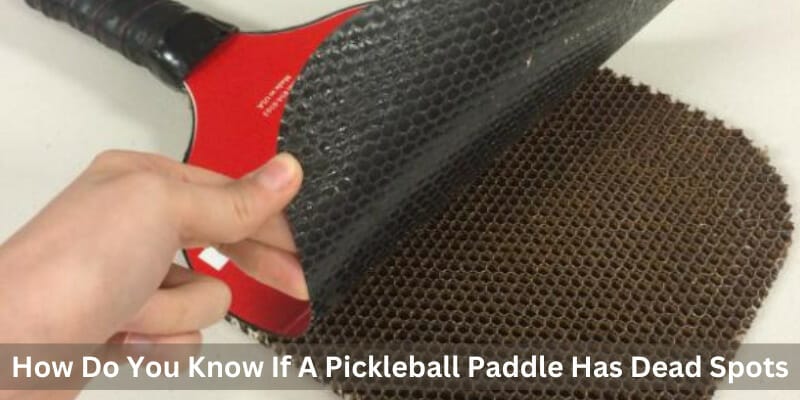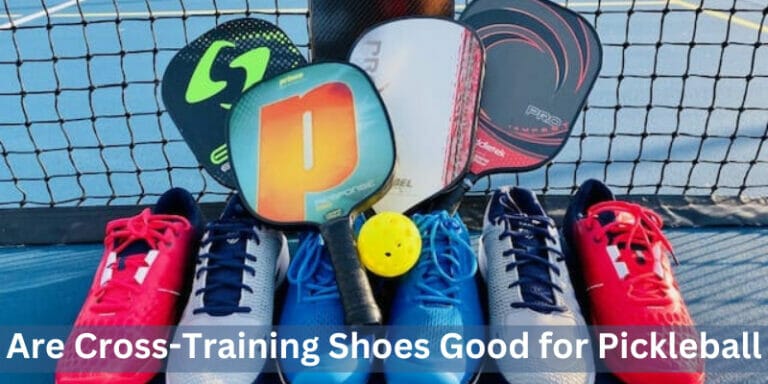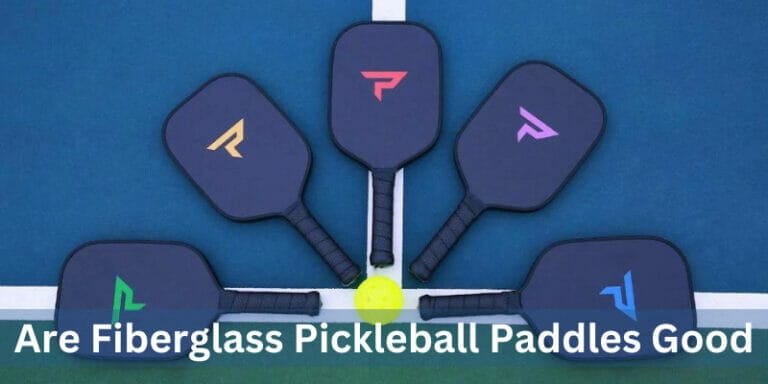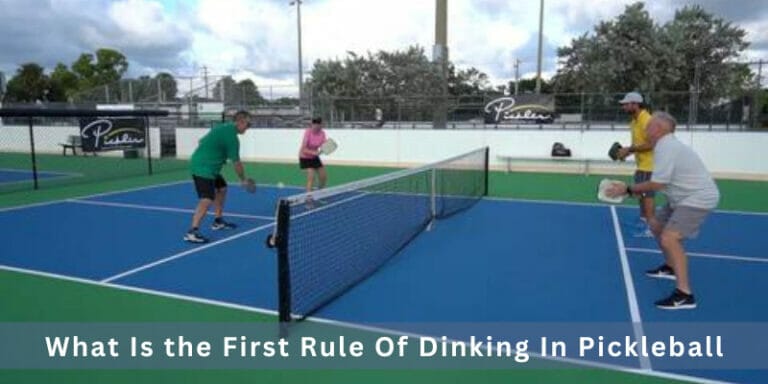How Do You Know If A Pickleball Paddle Has Dead Spots

Is your pickleball paddle letting you down? Learn how to detect dead spots and avoid a frustrating game.
Dead spots in a pickleball paddle can cause inconsistent shots and hinder your game. To test for dead spots, tap the paddle’s surface with a ball and listen for any dull or flat spots. If you hear dead spots, it’s time to replace the paddle for better game performance.
For months, I struggled with my pickleball shots, never quite sure what was going wrong. That was until a friend suggested I check my paddle for dead spots.
Curious, I tapped the paddle with a ball and realized there were flat spots all over. Without hesitation, I ordered a new paddle and was thrilled when it arrived.
The difference was immediate – my shots were more accurate and powerful.
I learned the importance of using the right equipment and keeping it in good condition. Thanks to my friend’s suggestion, my game has never been better.
I now regularly check my paddle for dead spots to avoid any future setbacks.
In this article, I am going to share every method through which you can identify dead spots on your pickleball paddle.
Let’s dive straight into it!
4 Methods of How Do You Know If A Pickleball Paddle Has Dead Spots
The following are the 4 best-advanced methods to identify dead spots on your pickleball paddle:
Method 1: Visually examine the surface of your pickleball paddle
A visual inspection of your pickleball paddle can also help you identify dead spots. Look for any unevenness, indentation, dents, dips, or other signs of damage. These can all be indicators of dead spots.
To perform a visual inspection, start by examining the surface of your paddle closely. Check for any areas that appear different from the rest of the paddle.
Dead spots may appear as indentations, dents, or dips on the surface. These areas may also appear to be worn down or discolored compared to the rest of the paddle.
You should also look for any other signs of damage, such as cracks or chips in the paddle’s surface.
While these may not necessarily indicate dead spots, they can still impact your performance on the court and should be addressed.
If you notice any signs of damage or dead spots on your paddle, it’s best to replace it as soon as possible.
A damaged or worn-out paddle can significantly impact your game, and investing in a new, high-quality paddle can help improve your performance and consistency on the court.
Method 2: Feel the difference while playing/ playing defaults
Another way to identify dead spots on a pickleball paddle is to pay attention to how it feels when you play.
Dead spots can cause inconsistencies in the way the ball reacts to the paddle. You may notice that your shots are not as powerful as they once were, or that the ball does not bounce off the paddle in the desired direction. These are all signs of dead spots.
To perform the playing test, you can try hitting different types of shots, including volleys, dinks, and serves, and pay attention to how the ball reacts.
If you notice a lack of control or inconsistency in your shots, it may be due to dead spots on your paddle.
Playing with a paddle that has dead spots can be frustrating and impact your overall game. It’s essential to address the issue as soon as possible by replacing the paddle with a high-quality one.
By combining the playing test with the sound test and visual inspection, you can accurately identify any dead spots on your paddle and ensure that you’re using the best possible equipment for your game.
Method 3: Check the sound/ Tap Test
The first and most straightforward way to check for dead spots on your pickleball paddle is to listen to the sound it makes when you tap it.
Dead spots result in a dull sound, as opposed to the crisp and clean sound you hear from a good paddle. If your paddle produces a dull sound when tapped, it is likely that it has dead spots.
To check for dead spots on your pickleball paddle, perform the sound test by tapping the face of the paddle in different spots.
A dull thud or low-pitched sound instead of a sharp, crisp sound indicates dead spots.
Dead spots can negatively affect your game by causing inconsistent ball bounces and a lack of control over your shots. Replace your paddle if you detect dead spots.
Combining sound tests with other methods such as ball bounce tests and visual inspection can help identify dead spots accurately and improve your performance on the court.
Method 4: Unable to hit the ball in the desired direction/ pay attention
A dead spot on a pickleball paddle can make it difficult to hit the ball in the desired direction. This is especially noticeable when trying to hit a particular shot, such as a dink or a lob.
If you find yourself struggling to hit the ball where you want it to go, it may be time to check your paddle for dead spots.
To perform this test, pay attention to how the ball reacts when you hit it with your paddle. If you notice that the ball doesn’t go where you intend it to or doesn’t have the right amount of power, it could be due to dead spots on your paddle.
Additionally, you may feel a lack of control when hitting the ball. It’s crucial to address dead spots on your paddle as they can significantly impact your performance on the court.
Not only can they make it difficult to execute your shots accurately, but they can also lead to frustration during a game.
Regularly checking your paddle for dead spots using various methods, such as the sound test, playing test, and visual inspection can help you identify any issues and ensure that you’re using the best possible equipment for your game.
Investing in a high-quality paddle is worth it in the long run and can significantly improve your overall performance on the court.
What are the Causes of dead pickleball paddles?
Dead spots on a pickleball paddle can be caused by a variety of factors. One of the most common causes is simply wearing and tear.
Over time, the surface of the paddle can become damaged, resulting in dead spots. Another cause is exposure to extreme temperatures.
Paddles that are left in hot or cold environments for extended periods can develop dead spots.
Finally, improper storage can also cause dead spots. Paddles that are stored in damp or humid environments can be susceptible to damage.
Another cause of dead spots on a pickleball paddle is the use of low-quality or inferior materials during the manufacturing process.
Paddles made from low-quality materials can develop dead spots more quickly, which can impact their overall performance.
C. Delaying the emergence of dead spots on a paddle
While it is impossible to completely avoid dead spots, there are steps you can take to delay their emergence.
- First, make sure to store your paddle in a dry and cool place. Avoid leaving it in the sun or in a car trunk for extended periods.
- Second, try not to hit the paddle against hard surfaces, such as the court or the net.
- Finally, make sure to use the right technique when hitting the ball. A proper technique can reduce the stress on the paddle and prevent damage.
- Regularly inspecting your paddle and addressing any damage as soon as possible can also help delay the emergence of dead spots.
- Investing in a high-quality paddle and replacing it when necessary can also prevent dead spots from affecting your game.
- Additionally, using a paddle cover can help protect your paddle from damage during transport or storage.
D. What is the average lifespan of a pickleball paddle?
The lifespan of a pickleball paddle can vary greatly depending on the quality of the paddle and how well it is cared for. On average, a well-made pickleball paddle can last for a few years with proper care.
However, if you play frequently or competitively, the lifespan of your paddle may be shorter. It is essential to inspect your paddle regularly and replace it if you notice any signs of damage or dead spots.
Factors like frequency of play, the intensity of play, storage conditions, and maintenance can also affect the lifespan of a pickleball paddle.
Paddles made with high-quality materials and construction techniques tend to last longer.
Additionally, taking good care of your paddle, such as cleaning it after each use and storing it in a protective cover, can also help prolong its lifespan.
E. How to prolong the life of your pickleball paddle?
To prolong the life of your pickleball paddle, it is crucial to take good care of it. Here are a few tips to help you do that:
- Store your paddle in a dry and cool place, away from direct sunlight or extreme temperatures. Keep your paddle clean by wiping it down with a damp cloth after each use.
- Avoid hitting the paddle against hard surfaces, such as the court or the net.
- Use a paddle cover to protect your paddle when not in use.
- Use the right technique when hitting the ball.
- A proper technique can reduce the stress on the paddle and prevent damage.
By following these tips, you can help extend the lifespan of your pickleball paddle and ensure that it continues to perform well for as long as possible.
Regularly inspecting your paddle for any signs of damage or dead spots and addressing them promptly can also help prolong its lifespan.
F. When to upgrade the pickleball paddle
If you notice any signs of dead spots or damage on your pickleball paddle, it may be time to upgrade to a new one.
A paddle with dead spots can greatly affect your game, making it harder to play and ultimately less enjoyable.
Additionally, as your skills improve, you may want to upgrade to a paddle that suits your playing style better.
Furthermore, if you are playing frequently or competitively, you may want to consider upgrading to a higher-quality paddle that is more durable and can withstand the wear and tear of intense gameplay.
Upgrading to a new paddle can also give you the opportunity to try out new technologies and features that can enhance your game.
Ultimately, it is up to you to decide when to upgrade your paddle, but it is recommended to replace it as soon as you notice any signs of damage or wear to ensure that you can continue to enjoy the game at your best level.
G. Can you play a pickleball paddle with a worn-out paddle?
Technically, you can still play with a worn-out paddle, but it will not perform as well as a new paddle.
A paddle with dead spots can greatly affect your game, making it harder to play and ultimately less enjoyable.
Additionally, a worn-out paddle may not meet the requirements for tournament play, so it is essential to inspect your paddle regularly and replace it if necessary.
Playing with a worn-out paddle may also increase the risk of injury as it may not provide the necessary control and power for your shots.
In addition, a paddle that is too heavy or too light can also affect your game negatively.
Therefore, it is important to not only replace a worn-out paddle but also choose a paddle that suits your playing style and skill level for optimal performance and safety.
H. How long should a pickleball paddle last?
The lifespan of a pickleball paddle can vary greatly depending on the quality of the paddle and how well it is cared for. On average, a well-made pickleball paddle can last for a few years with proper care.
However, if you play frequently or competitively, the lifespan of your paddle may be shorter. It is essential to inspect your paddle regularly and replace it if you notice any signs of damage or dead spots.
Factors such as the material, frequency of use, and playing style can also affect the lifespan of a pickleball paddle.
Carbon fiber paddles, for example, tend to have a longer lifespan than wood paddles. If you play regularly, it is recommended to inspect your paddle every few months to ensure it is still in good condition.
If you notice any signs of wear or damage, it may be time to consider replacing it to avoid any negative impact on your game.
Conclusion
A dead spot on a pickleball paddle can greatly affect your game, making it harder to play and ultimately less enjoyable.
By using the methods outlined in this article, you can easily identify dead spots on your paddle and take the necessary steps to prevent or delay their emergence.
With proper care, you can prolong the life of your pickleball paddle and continue to enjoy the game for years to come.
FAQs
Why Does My Pickleball Paddle Feel Dead?
There are a few reasons why your pickleball paddle may feel dead, including old age, wear, and tear, or damage.
Over time, the materials can lose their responsiveness, leading to a less satisfying playing experience. Consider replacing or repairing the paddle to improve its performance.
How Do You Know If A Pickleball Paddle Is Good?
A good pickleball paddle should be lightweight, durable, and have a comfortable grip.
It should also have a responsive surface with a good balance of power and control. Testing out different paddles and reading reviews can help determine which one is right for you.
Do Pickleball Paddles Wear Out?
Yes, pickleball paddles can wear out over time due to normal usage, such as hitting the ball and scraping against the court surface.
The surface may become less responsive, and the core may lose its resilience. It’s important to replace worn-out paddles to maintain optimal playing performance.
How Often Do You Change Your Pickleball Paddle?
The frequency of changing your pickleball paddle depends on how often you play and how much wear and tear the paddle receives.
On average, players may replace their paddle every 6 to 12 months or after noticing a decline in performance.
However, some paddles can last for several years with proper care.






